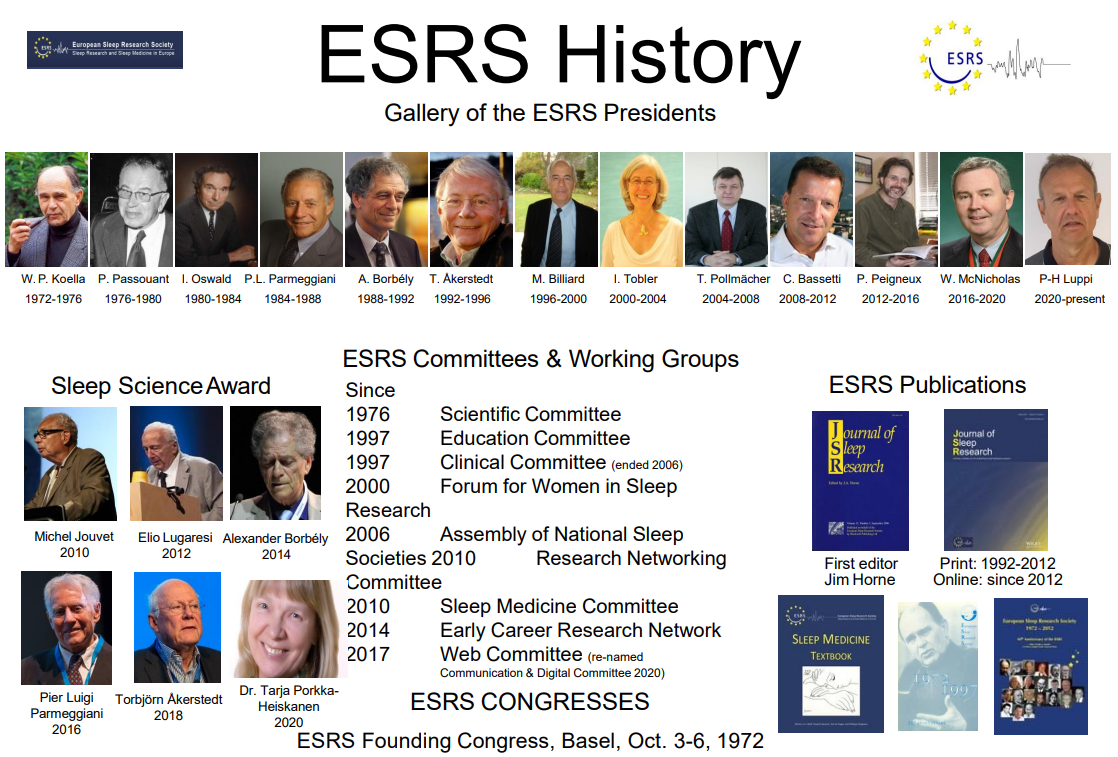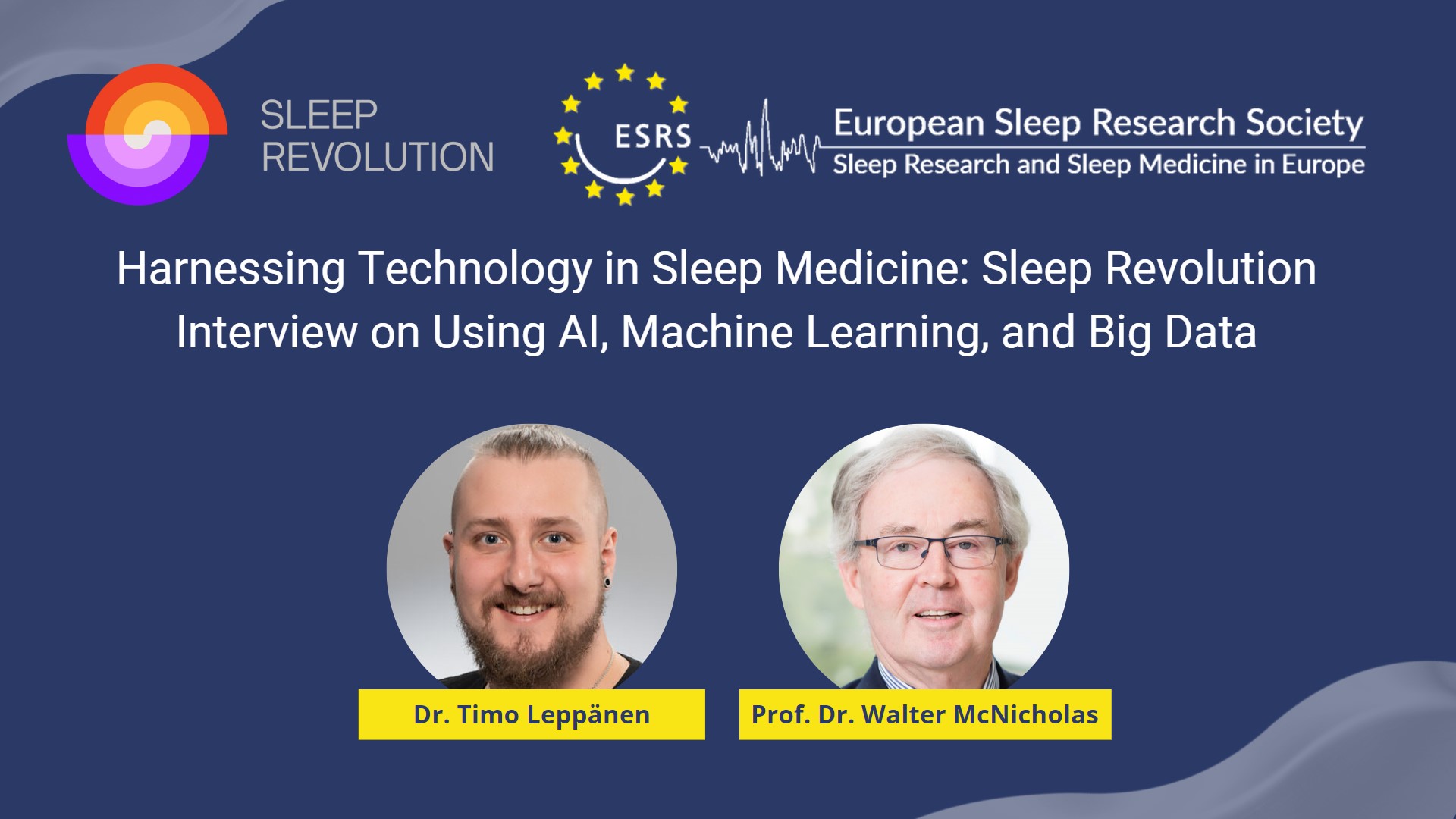Harnessing Technology in Sleep Medicine: Sleep Revolution Interview on Using AI, Machine Learning, and Big Data

Dr. Timo Leppänen
Associate Professor at the Department of Applied Physics, University of Eastern Finland (UEF), Kuopio, Finland. Sleep Revolution Executive Board member.

Prof. Dr. Walter McNicholas
Consultant in respiratory sleep medicine at St. Vincent's Hospital in Dublin, and professor at the Department of Respiratory and Sleep Medicine, University College Dublin (UCD), Dublin, Ireland. ESRS’ Board Advisory member, ESRS' Sleep Medicine Committee member and Sleep Revolution Executive Board member.
In this Sleep Science Friday publication, Prof. Dr. Walter McNicholas, the previous European Sleep Research Society President, currently one of the ESRS’ board advisory member and ESRS’ liaison in the Sleep Revolution Project, interviews Dr. Timo Leppänen, an associate professor at the University of Eastern Finland, one of the leaders of the Sleep Revolution project and also a work package leader in the project. Among several interesting updates on the project, they discuss the use of artificial intelligence (AI) and machine learning models on sleep research and medicine fields, for big data analysis and predictive analytics to develop tools that automate sleep analysis.
Overview of the Sleep Revolution project and its objectives
The Sleep Revolution project is a four-year EU Horizon 2020 funded initiative worth almost 15 million euros, with 39 partners from Europe and one from Australia, involving 20 countries. The Sleep Revolution goal is to revolutionise the diagnosis and management of patients with sleep-related breathing disorders, aiming to update clinical diagnostic tools for sleep-disordered breathing (SDB), bring advanced diagnostics from labs to homes, involve patients more in their own health management using wearable solutions (consumer sleep technology), like smartwatches and fit bands, tailor personalised treatment options based on personalised phenotyping and endotyping, and reduce cost financial burdens on healthcare systems through early diagnosis and management that can prevent severe comorbidities like stroke or heart failure.
Addressing Suspicion Towards Sleep Automated Analysis
The project also aims to overcome scepticism towards automated analysis by ensuring comparable accuracy to manual scoring through inter-rater agreement calculations between specialists / clinicians, and by testing the automatic tools in prospective trials to increase trust and facilitate implementation in clinical practice.
Use of a Three-Dimensional Model to Improve Diagnosis
Additionally, Sleep Revolution aims to address limitations associated with assessing disease severity by using a three-dimensional model that considers respiratory events (including the number and duration of the events), acute systemic effects (desaturations, arousals, blood pressure changes), chronic end organ impacts (symptoms, comorbidities), introducing new parameters as supplements to existing measures like AHI (Apnea-Hypopnea Index) such as desaturation severity and hypoxic burden for example.
Estimating Comorbidities and Outcomes
Machine learning algorithms from artificial intelligence (AI) tools analyse raw signals without any scoring as inputs, to find features, biomarkers, and characteristics to predict certain outcomes (e.g., risk for comorbidities, risk for short time symptoms like daytime sleepiness or impaired vigilance). For example, using EEG and EKG data to find characteristics linked to different comorbidities and outcomes that may be overlooked when relying solely on AHI scores. The project also addresses criticisms of existing measures like the ESS (the Epworth Sleepiness Scale, a self-administered questionnaire widely used in the field of sleep medicine as a subjective measure of a patient’s sleepiness), by developing the European Sleep questionnaire uses additional measurements from the psychomotor vigilance tasks time series.
Overall, the Sleep Revolution project has promising potential for a paradigm shift in diagnosing and managing patients with sleep breathing disorders.
The Sleep Revolution
Obstructive sleep apnea (OSA) is the most frequently encountered sleep disordered breathing disorder, associated with various health complications such as a high risk of heart disease, hypertension, and daytime sleepiness. Despite its negative impact and various comorbidities, OSA remains poorly diagnosed and ineffectively treated. The EU-funded SLEEP REVOLUTION project is introducing an approach based on machine learning to assess OSA severity and treatment needs. Through a set of wearables and a digital management platform, the project aims to bring together researchers, patients, and healthcare professionals to provide a state-of-the-art method of accurate OSA diagnosis and optimal treatment.
From “SLEEP REVOLUTION”. Sleep Revolution. https://sleeprevolution.eu/. Accessed 28 July 2023.
ESRS Involvement with the Sleep Revolution
The ESRS is responsible for the “Work Package 12: Standardisation and Dissemination”, which involves facilitating the co-ordination and dissemination of findings from the many research projects carried out by the Sleep Revolution consortium. Find out more about the ESRS and Sleep Revolution association.
"We are in a decade of several revolutions in the way we deal with sleep technology, there is Artificial Intelligence (AI) coming in, there is Deep Learning coming in, and we have to bring this new vocabulary into our daily practice."
Gabriel Natan Pires
"Consumer Sleep Technology refers to devices and apps used by customers for sleep tracking (and some for treatment) without the need for medical professionals or any medical prescription, to be used in the point of care."
Gabriel Natan Pires
Watch the video interview below for a comprehensive description on the Sleep Revolution project. Don’t miss this very enlightening talk between Timo and Walter.
Recent publications from ESRS members
- Karimi, Hedner and Grote (2023). Changes in cognitive function and daytime sleepiness in patients with chronic heart failure and Cheyne-Stokes respiration with adaptive servo ventilation treatment. Sleep Med.
- Gunter et al. (2023). SViT: a Spectral Vision Transformer for the Detection of REM Sleep Behavior Disorder. IEEE J Biomed Health Inform.
- Rusanen et al. (2023). Self-applied somnography: technical feasibility of electroencephalography and electro- oculography signal characteristics in sleep staging of suspected sleep- disordered adults. J Sleep Res.
- Lammintausta et al. (2023). Clinical characteristics and positive airway pressure adherence among elderly European sleep apnoea patients from the ESADA cohort. ERJ Open Res.
- Howarth et al. (2023). Oxygen resaturation rate is significantly associated with objectively assessed excessive daytime sleepiness in suspected obstructive sleep apnoea patients. Sleep Med.
- Donovan et al. (2023). Strategies to Assess the Effect of Continuous Positive Airway Pressure on Long-Term Clinically Important Outcomes among Patients with Symptomatic Obstructive Sleep Apnea: An Official American Thoracic Society Workshop Report. Ann Am Thorac Soc.
- Somerville et al. (2023). NPC1 variants are not associated with Parkinson’s disease, REM-sleep behavior disorder or dementia with Lewy bodies in European cohorts. Neurobiol Aging.



